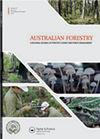The impact of whitegrub (Coleoptera: Scarabaeidae) damage on growth of Eucalyptus grandis and Acacia mearnsii plantation trees in South Africa
IF 0.9
4区 农林科学
Q3 FORESTRY
引用次数: 0
Abstract
ABSTRACT Eucalyptus grandis and Acacia mearnsii are among the South African forest industry’s most planted commercial species. Whitegrubs are high-status pests affecting plantation forestry; they are root-feeding insects and cause poor seedling growth and elevated mortality. The aim of this study was to elucidate the impact of whitegrub damage on the growth of E. grandis and A. mearnsii trees during the first year of the establishment stage in sites previously planted with A. mearnsii in the KwaZulu-Natal Midlands of South Africa. The hypothesis was that the prophylactic application of insecticides against whitegrubs would increase tree height at six or 12 months after planting. Seven insecticides were assessed in 12 treatments over three trials in Bloemendal, KwaZulu-Natal. Statistical analyses were performed using PRIMER and SAS. Whitegrubs were the predominant mortality factor (17.1%), followed by pathogens (3.3%) and 12 other factors that cumulatively caused the remaining (7.0%) mortality. Pegylis sommeri, Schizonycha affinis and two unknown Maladera species were the most important, typical and prevalent whitegrub species, but their ranking differed between A. mearnsii and E. grandis, suggesting a host preference. The prophylactic application of insecticides against whitegrubs significantly increased tree height for E. grandis. Acacia mearnsii tree height, however, did not consistently show a significant effect with insecticide control, presumably because of additional mortality by pathogens. The crop-rotation scenario may have potentially benefited E. grandis over A. mearnsii and warrants further investigation. Whitegrubs can kill seedlings and reduce tree height when left uncontrolled.白蚁对南非大桉和金合欢人工林生长的影响
大桉(Eucalyptus grandis)和金合欢(Acacia mearnsii)是南非森林工业种植最多的商业树种。白蛉是影响人工林的重要害虫;它们是食根昆虫,导致幼苗生长不良和死亡率升高。本研究的目的是阐明在南非夸祖鲁-纳塔尔省中部地区以前种植过黑桫椤的地点,白蛴螬对大桫椤和黑桫椤树在建立阶段的第一年生长的影响。他们的假设是,在种植后6个月或12个月,预防性地使用杀虫剂来对付白蛉会增加树的高度。在夸祖鲁-纳塔尔省Bloemendal进行了3次试验,评估了7种杀虫剂的12种处理方法。采用PRIMER和SAS进行统计学分析。白蛴螬是主要致死因素(17.1%),致病菌次之(3.3%),其他12种因素累计致死(7.0%)。白蛴螬中最重要、最典型和最普遍的种是Pegylis sommeri、Schizonycha affinis和2个未知的Maladera种,但它们在mearnsii和e.grandis之间的排名存在差异,表明它们存在寄主偏好。预防使用杀虫剂可显著提高大叶白蛴螬的树高。然而,金合欢树高在杀虫剂控制下并没有持续显示出显著的效果,可能是因为病原体增加了死亡率。轮作方案可能潜在地使大叶蝉比小叶蝉受益,值得进一步调查。如果不加以控制,蛴螬会杀死幼苗,降低树木高度。
本文章由计算机程序翻译,如有差异,请以英文原文为准。
求助全文
约1分钟内获得全文
求助全文
来源期刊

Australian Forestry
FORESTRY-
CiteScore
3.70
自引率
4.80%
发文量
15
审稿时长
>12 weeks
期刊介绍:
Australian Forestry is published by Taylor & Francis for the Institute of Foresters of Australia (IFA) for scientific, technical, and professional communication relating to forestry in the Asia Pacific.
 求助内容:
求助内容: 应助结果提醒方式:
应助结果提醒方式:


